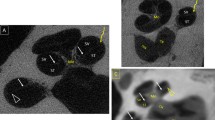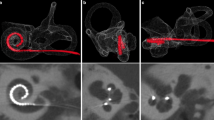Abstract
Purpose
Severe cochleovestibulopathy is a complication after stapes plasty and CT may be needed to assess intravestibular intrusion depth of the stapes piston. The accuracy of modern CT systems in this task has not been established.
Methods
Stapes plasty was performed on six cadaver ears, and Soft CliP titanium pistons were inserted. Specimens were then examined using three different CT systems: single source 64-row, dual source 64-row and flat-panel computed tomography (FD-CT). Piston length, width and intravestibular intrusion were measured by four independent observers. Temporal bone dissection was then performed and vestibular piston intrusion measured microscopically.
Results
Piston dimensions were overestimated by all observers and CT systems. Intravestibular penetration as assessed by CT was consistently greater than the value found on cadaveric anatomical dissection. On average, the CT measurement of width was 0.176 mm (44%) greater, length 0.125 mm (6.25%) greater and intrusion 0.333 mm (39.2%) greater than the anatomical measurements. FD-CT showed better image quality and partly less bias in several measurements, but penetration depth was still variably overestimated.
Conclusion
CT measurement consistently overestimated intravestibular piston dimensions and vestibular intrusion. Modern temporal bone imaging systems are not yet able to depict the stapes piston position with a sufficient degree of accuracy.




Similar content being viewed by others
References
Hausler R (2007) General history of stapedectomy. Adv Otorhinolaryngol 65:1–5
Kosling S, Brandt S, Bloching M, Bohme S (2004) Indications of HR-CT in the early postoperative phase of stapedotomy. Rofo 176:1122–1126
Oberascher G, Grobovschek M (1987) High-resolution computed tomography in stapes surgery. HNO 35:255–261
Oberascher G, Grobovschek M (1988) Identification of middle ear implants in high-resolution computerized tomography. Laryngol Rhinol Otol (Stuttg) 67:17–22
Woldag K, Meister EF, Kosling S (1995) Diagnosis in persistent vertigo after stapes surgery. Laryngorhinootologie 74:403–407
Albera R, Canale A, Lacilla M, Cavalot AL, Ferrero V (2004) Delayed vertigo after stapes surgery. Laryngoscope 114:860–862
Backous DD, Minor LB, Aboujaoude ES, Nager GT (1999) Relationship of the utriculus and sacculus to the stapes footplate: anatomic implications for sound-and/or pressure-induced otolith activation. Ann Otol Rhinol Laryngol 108:548–553
Pauw BK, Pollak AM, Fisch U (1991) Utricle, saccule, and cochlear duct in relation to stapedotomy. A histologic human temporal bone study. Ann Otol Rhinol Laryngol 100:966–970
Hahn Y, Diaz R, Hartman J, Bobinski M, Brodie H (2009) Assessing stapes piston position using computed tomography: a cadaveric study. Otol Neurotol 30(2):223–230
Kosling S, Woldag K, Meister EF, Reschke I, Heywang-Kobrunner SH (1995) Value of computed tomography in patients with persistent vertigo after stapes surgery. Invest Radiol, 30:712–715
Roosli C, Hoffmann A, Treumann T, Linder TE (2008) Significance of computed tomography evaluation before revision stapes surgery. HNO 56:895–900
Warren FM, Riggs S, Wiggins RH 3rd (2008) Computed tomographic imaging of stapes implants. Otol Neurotol 29:586–592
Swartz JD, Lansman AK, Berger AS et al (1986) Stapes prosthesis: evaluation with CT. Radiology, 158:179–182
Pickuth D, Brandt S, Berghaus A, Spielmann RP, Heywang-Kobrunner SH (2000) Vertigo after stapes surgery: the role of high resolution CT. Br J Radiol 73:1021–1023
Henrot P, Iochum S, Batch T, Coffinet L, Blum A, Roland J (2005) Current multiplanar imaging of the stapes. AJNR Am J Neuroradiol 26:2128–2133
Chakeres DW (1984) Clinical significance of partial volume averaging of the temporal bone. AJNR Am J Neuroradiol 5:297–302
Author information
Authors and Affiliations
Corresponding author
Rights and permissions
About this article
Cite this article
Bozzato, A., Struffert, T., Hertel, V. et al. Analysis of the accuracy of high-resolution computed tomography techniques for the measurement of stapes prostheses. Eur Radiol 20, 566–571 (2010). https://doi.org/10.1007/s00330-009-1582-4
Received:
Accepted:
Published:
Issue Date:
DOI: https://doi.org/10.1007/s00330-009-1582-4




